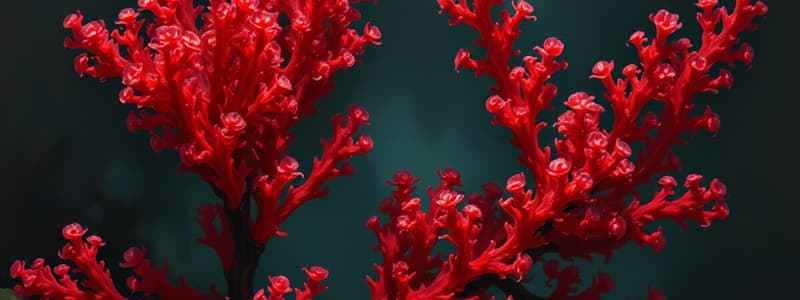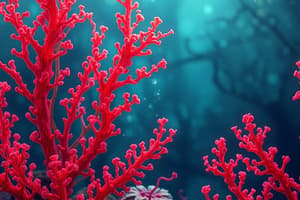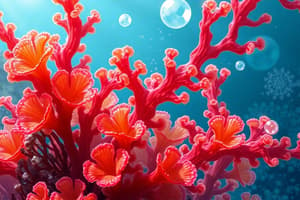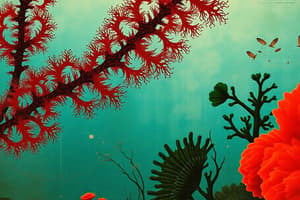Podcast
Questions and Answers
What is the classification of phylum Rhodophyta?
What is the classification of phylum Rhodophyta?
Rhodophyceae
Phylum Rhodophyta is also called?
Phylum Rhodophyta is also called?
Red Algae
What causes the red color in Rhodophyta? (Select all that apply)
What causes the red color in Rhodophyta? (Select all that apply)
- Carotenoids
- Phycocyanin (correct)
- Chlorophyll A (correct)
- Phycoerythrin (correct)
What are the other colors of Phylum Rhodophyta? (Select all that apply)
What are the other colors of Phylum Rhodophyta? (Select all that apply)
Give examples of the red algae:
Give examples of the red algae:
What are the characteristics of Rhodophyta? (Select all that apply)
What are the characteristics of Rhodophyta? (Select all that apply)
How long do red algae grow?
How long do red algae grow?
Do red algae have flagella and centrioles?
Do red algae have flagella and centrioles?
Do red algae have photosynthetic pigments?
Do red algae have photosynthetic pigments?
The red algae's food is in what form?
The red algae's food is in what form?
The red algae's polymers are in what form?
The red algae's polymers are in what form?
Where are red algae found? (Select all that apply)
Where are red algae found? (Select all that apply)
Where do red algae typically grow?
Where do red algae typically grow?
What is the red algae's mode of nutrition? (Select all that apply)
What is the red algae's mode of nutrition? (Select all that apply)
The red algae's cells are made of? (Select all that apply)
The red algae's cells are made of? (Select all that apply)
What is the Rhodophyta's male sex organ called?
What is the Rhodophyta's male sex organ called?
What is the Rhodophyta's female sex organ called?
What is the Rhodophyta's female sex organ called?
What are the 3 modes of production in red algae? (Select all that apply)
What are the 3 modes of production in red algae? (Select all that apply)
What happens during asexual reproduction?
What happens during asexual reproduction?
What happens during sexual reproduction?
What happens during sexual reproduction?
What are the 2 subclasses of Rhodophyta? (Select all that apply)
What are the 2 subclasses of Rhodophyta? (Select all that apply)
What is Bangiodeae?
What is Bangiodeae?
What order belongs to Bangiodeae?
What order belongs to Bangiodeae?
What is the characteristic of the thallus in Bangioles?
What is the characteristic of the thallus in Bangioles?
How does Bangioles reproduce?
How does Bangioles reproduce?
What do the cells of Bangioles contain?
What do the cells of Bangioles contain?
Give an example of Bangioles:
Give an example of Bangioles:
What subclass of Rhodophyta have cells connected by evident cytoplasmic strands?
What subclass of Rhodophyta have cells connected by evident cytoplasmic strands?
What are the characteristics of Florideae? (Select all that apply)
What are the characteristics of Florideae? (Select all that apply)
What are the algae that belong to this subclass? (Select all that apply)
What are the algae that belong to this subclass? (Select all that apply)
What is Nemalionales?
What is Nemalionales?
What are the characteristics of Nemalionales? (Select all that apply)
What are the characteristics of Nemalionales? (Select all that apply)
What is an example of Nemalionales?
What is an example of Nemalionales?
What is Gelidiales?
What is Gelidiales?
What are the characteristics of Gelidiales? (Select all that apply)
What are the characteristics of Gelidiales? (Select all that apply)
What is an example of Gelidiales?
What is an example of Gelidiales?
What are Cryptonemiales?
What are Cryptonemiales?
What are the characteristics of Cryptonemiales? (Select all that apply)
What are the characteristics of Cryptonemiales? (Select all that apply)
Flashcards are hidden until you start studying
Study Notes
Classification
- Phylum Rhodophyta is classified as Rhodophyceae.
- Commonly known as Red Algae.
Coloration
- Red coloration results from pigments: chlorophyll A, phycocyanin, and phycorythrin.
- Other hues include greenish, pink, and purple.
Examples
- Notable species of red algae include Botryocladia, Stenogramme, Gigartina, and Gelidium.
Characteristics
- Members are unicellular and typically attach to rocks in intertidal zones.
- Known for developing feathery structures and having flattened blades.
Growth
- Red algae can grow from 200 meters (656 feet) to 269 meters (884 feet).
- They lack flagella and centrioles.
Photosynthetic Capability
- Red algae possess photosynthetic pigments and store food primarily in the form of starch.
Composition
- The polymers found in red algae include galactan sulphate.
- Cell walls consist of cellulose and various polysaccharides.
Habitat
- Red algae thrive in both saltwater and freshwater environments, mainly in marine settings.
Nutritional Mode
- They exhibit saprophytic, parasitic, and epiphytic modes of nutrition.
Reproduction
- Male sex organs are termed spermatangium, while female organs include carpogonia or procarp.
- Three modes of reproduction are evident: vegetative, asexual, and sexual.
- Asexual reproduction involves the formation of monospores, while sexual reproduction shows alterations of generations.
Subclasses
- Two primary subclasses are Bangiodeae and Florideae.
Bangiodeae
- Characterized by a lack of growing points and filamentous or foliose thalli.
- Reproduces asexually through monospores.
- Contains one or two chromatophores in its cells.
- Example includes porphyta perforata.
Florideae
- Cells in this subclass are interconnected by cytoplasmic strands.
- Noted for filamentous body structure and complex sexual reproduction.
- Included orders are Nemalionales, Gelidiales, Cryptonemiales, Gigartinales, Rhodymeniales, and Ceramiales.
Nemalionales
- Known for a gametophytic generation with carpospores from short filaments sprouting from carpogonia.
- Characteristics include bluish or violet-green coloration, multicellularity, and smooth, branched bodies.
- Example: Batrachospermum.
Gelidiales
- A small order containing Gelidium and closely related genera.
- Best known as a source of agar.
- Thalli feature a single apical cell with unicellular carpogonial filaments.
- Example: Gelidium spp.
Cryptonemiales
- Distinguished by auxiliary cells on distinctly structured filaments.
- Thalli are monoaxial, with the auxiliary cells found on gametophyte filaments.
Studying That Suits You
Use AI to generate personalized quizzes and flashcards to suit your learning preferences.




